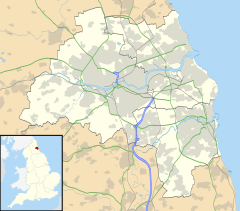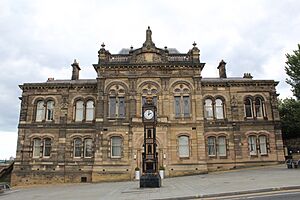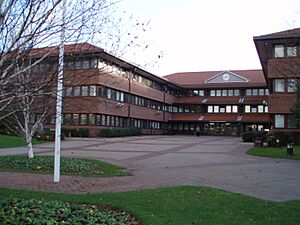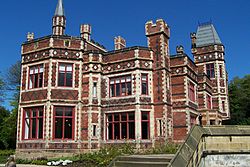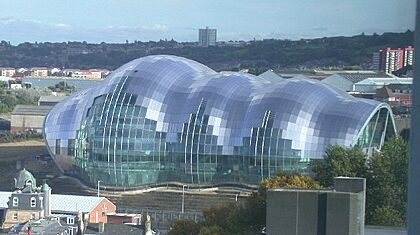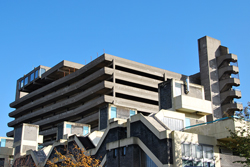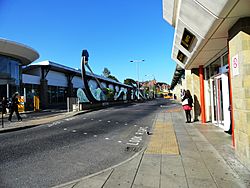Gateshead facts for kids
Quick facts for kids Gateshead |
|
|---|---|
| Town | |
|
|
| Population | 199,139 |
| OS grid reference | NZ2460 |
| Metropolitan borough |
|
| Metropolitan county | |
| Region | |
| Country | England |
| Sovereign state | United Kingdom |
| Post town | GATESHEAD |
| Postcode district | NE8-NE11 |
| Dialling code | 0191 |
| Police | Northumbria |
| Fire | Tyne and Wear |
| Ambulance | North East |
| EU Parliament | North East England |
| UK Parliament |
|
Gateshead is a lively town in Tyne and Wear, England. It sits on the southern bank of the River Tyne. Gateshead is famous for its amazing landmarks. These include the huge Angel of the North sculpture and the The Glasshouse International Centre for Music. The town also shares several bridges with its neighbour, Newcastle upon Tyne, like the Millennium Bridge.
Long ago, Gateshead was part of County Durham. But in 1888, it became a special area called a county borough. This meant it managed itself, separate from the main county council. In 2021, about 196,151 people lived in Gateshead.
Contents
- Discovering Gateshead's Past
- How Gateshead is Governed
- Gateshead's Location and Landscape
- People of Gateshead
- Gateshead's Economy and Culture
- Gateshead's Architecture and Buildings
- Sports in Gateshead
- Getting Around Gateshead
- Places of Worship in Gateshead
- Gateshead's Twin Towns
- Famous People from Gateshead
- See also
Discovering Gateshead's Past
What's in a Name? Gateshead's Origins
The name Gateshead first appeared in old writings around 623 AD. A monk named Bede wrote about it in Latin as ad caput caprae. This means "at the goat's head." Later English versions, like Gatesheued, also meant "goat's head." This name likely described a hill or headland where wild goats often gathered.
Some people think the name might come from an even older language. It could be linked to the Roman-British fort called Gabrosentum.
Early Settlements and Important Events
People have lived on the Gateshead side of the River Tyne since Roman times. This area was important because it was near an old river crossing. The first time Gateshead was officially mentioned was in 623 AD. This was when the Venerable Bede wrote about an abbot named Utta from Gateshead.
A big battle happened in Gateshead in 1068. William the Conqueror defeated the forces of Edgar the Ætheling and Malcolm, the King of Scotland. During the Middle Ages, the Bishop of Durham ruled Gateshead. Most of the area was covered in forests, with some farmland.
The Industrial Revolution and Growth
During the Industrial Revolution, Gateshead grew very quickly. Between 1801 and 1901, the town's population increased by over 100,000 people! This growth caused the town to spread further south.
In 1854, a huge explosion happened on the quayside. This "Great Fire of Newcastle and Gateshead" destroyed much of Gateshead's old buildings. It also caused a lot of damage across the river in Newcastle.
Sir Joseph Swan, a famous inventor, lived in Gateshead from 1869 to 1883. He did experiments there that led to the invention of the electric light bulb. His house was the first in the world to have electric lights!
In 1889, a very large company, Hawks, Crawshay and Sons, closed down. This caused many people to lose their jobs. Unemployment became a big problem for Gateshead. To help with this, the Team Valley Trading Estate was built in the 1930s. This created new jobs for many people.
Modern Gateshead: A Time of Change

In the 2000s, Gateshead Council began to make the town better. Their goal was to turn Gateshead into a city. The biggest changes happened along the Quayside. Many buildings there were built new or made over.
In the early 2010s, the focus shifted to the town centre. The £150 million Trinity Square development opened in 2013. It includes student homes, a cinema, a health centre, and shops.
How Gateshead is Governed
Past Governance of Gateshead
In 1835, Gateshead became a municipal borough. This meant it had its own local government. Then, in 1889, it became a county borough. This gave it even more independence from the main Durham County Council.
The Old Town Hall was built in 1870. It was designed by John Johnstone. He also designed the Newcastle Town Hall. The beautiful clock in front of the old town hall was a gift from the mayor, Walter de Lancey Willson, in 1892. The old town hall was also used as a court and a police station.
Gateshead's Current Government
In 1974, the County Borough of Gateshead joined with other nearby areas. These included Felling, Whickham, and Blaydon. Together, they formed the much larger Metropolitan Borough of Gateshead. This is how Gateshead is governed today. The main council building is the Gateshead Civic Centre, which was finished in 1987.
Gateshead's Location and Landscape
Gateshead is in the North East of England. It is part of Tyne and Wear county. The town is on the southern bank of the River Tyne.
Gateshead has a mild climate. It is warmer than some other places at the same latitude. This is because of the warming effect of the Gulf Stream. Gateshead is also in a "rain shadow." This means it is one of the driest places in the United Kingdom.
One special thing about Gateshead is its hills. The land rises quite a lot from the Gateshead Quays to the town centre. It keeps rising to a height of 525 feet in Sheriff Hill. This is very different from the flat Team Valley area on the western side of town. From the high points, you can see amazing views over the Tyne valley. You can even see Newcastle upon Tyne and the North Sea.
The Office for National Statistics sees Gateshead as a town subdivision. This includes the historic area of Gateshead. It also includes areas the town has grown into, like Dunston and Felling.
Gateshead is very close to Newcastle. Because of this, some people mistakenly think it's part of Newcastle. To help promote the whole area, Gateshead Council and Newcastle City Council created a joint brand: NewcastleGateshead.
Understanding Gateshead's Climate
Gateshead has an Oceanic climate. This means it has small differences between high and low temperatures. It also gets enough rainfall all year round. The weather box below shows the average temperatures and rainfall.
| Climate data for Gateshead, UK | |||||||||||||
|---|---|---|---|---|---|---|---|---|---|---|---|---|---|
| Month | Jan | Feb | Mar | Apr | May | Jun | Jul | Aug | Sep | Oct | Nov | Dec | Year |
| Mean daily maximum °C (°F) | 7 (45) |
8 (46) |
10 (50) |
11 (52) |
14 (57) |
17 (63) |
19 (66) |
20 (68) |
17 (63) |
13 (55) |
10 (50) |
7 (45) |
13 (55) |
| Mean daily minimum °C (°F) | 3 (37) |
3 (37) |
4 (39) |
5 (41) |
8 (46) |
10 (50) |
13 (55) |
13 (55) |
10 (50) |
7 (45) |
5 (41) |
3 (37) |
7 (45) |
| Average precipitation mm (inches) | 43 (1.7) |
41 (1.6) |
38 (1.5) |
66 (2.6) |
48 (1.9) |
61 (2.4) |
48 (1.9) |
61 (2.4) |
51 (2) |
61 (2.4) |
66 (2.6) |
56 (2.2) |
640 (25.3) |
| Source: Weatherbase | |||||||||||||
Gateshead's Green Spaces
Gateshead has a "Green Belt" area around it. This is a special protected zone of countryside. It helps stop towns from growing into each other. It also protects the natural environment. The Green Belt makes sure that Gateshead does not merge with nearby towns like Hebburn or Whickham. It also encourages old city areas to be reused instead of building on new land.
The Green Belt includes many small villages and hamlets. It also has woods, nature reserves, and golf courses.
Areas and Neighbourhoods in Gateshead
The town of Gateshead is made up of many different areas. Some of these were once separate villages that Gateshead grew to include. Others are new areas with shops, factories, and homes. Many of these areas blend into each other. Gateshead is the main part of the larger Tyneside urban area.
- Gateshead town centre
- Bensham
- Team Valley
- Team Valley Trading Estate
- Deckham
- Mount Pleasant
- Carr Hill
- Old Fold
- Shipcote
- Bridges
- Central
- Redheugh
- Chowdene
- Harlow Green
- Dunston and Teams
- Low Teams
- Swalwell
- Low Fell
- Whickham East
- Dunston Hill
- High Fell
- Black Hill
- Sheriff Hill
- Ravensworth
- Beacon Lough
- Egremont Estate
- Low Fell
- Lyndhurst
- Allerdene
- Saltwell
- Shipcote
- Wardley and Leam Lane
- Follingsby
- Pelaw and Heworth
- Bill Quay
- Felling
- North Felling/ Felling Shore
- Falla Park
- Sunderland Road
- Lamesley
- Wrekenton
- Eighton Banks
- Windy Nook and Whitehills
- Staneway
- Whitehills Estate
People of Gateshead
In 2011, Gateshead town had a population of 120,046 people. This was an increase from 78,403 in 2001. The increase is partly because the town's boundaries changed. Areas like Felling are now considered part of Gateshead town.
The table below shows the different backgrounds of people in Gateshead compared to the wider Gateshead borough in 2011.
| Gateshead Ethnicity 2011 | White British | Asian | Black |
|---|---|---|---|
| Gateshead | 92.0% | 2.5% | 0.8% |
| Metropolitan Borough of Gateshead | 94.0% | 1.9% | 0.5% |
In 2011, about 8.0% of people in Gateshead town were from an ethnic minority group. This is higher than the 6.0% for the whole borough. The Tyneside area, which includes Gateshead, has a population of 829,300. Gateshead town makes up about 60% of the borough's population.
Gateshead's Economy and Culture
Gateshead is home to some very important places for business and culture. The MetroCentre is one of the largest shopping centres in the UK. The Team Valley Trading Estate is also one of the biggest business parks in the UK.
Arts and Culture in Gateshead
The Baltic Centre for Contemporary Art is a modern art gallery. It is located in an old flour mill. The Glasshouse International Centre for Music, designed by famous architect Norman Foster, opened in 2004. It is a fantastic place for music and performances.
Gateshead also hosted the Gateshead Garden Festival in 1990. This event transformed 200 acres of unused land. Most of this land is now used for housing.
The Angel of the North is a very famous sculpture. It is located near Gateshead and can be seen from the A1 road. Other public artworks in Gateshead include pieces by Richard Deacon and Andy Goldsworthy.
Traditional Industries and Past Work
Coal mining started in Gateshead as early as 1344. As trade grew on the River Tyne, Newcastle merchants tried to take control of Gateshead. In 1576, a group of Newcastle merchants gained control of the coal mines in Gateshead. Coal shipments from Newcastle increased a lot, and Gateshead's population doubled. However, these coal supplies eventually ran out in 1680. The mines were shallow, and it was hard to dig deeper because of water and air problems.
William Cotesworth (1668-1726) was a very important merchant in Gateshead. He was a leader in coal and international trade. He started as an apprentice and became a mayor and a Justice of the Peace. He traded many goods, including dyes, flax, wine, and grain. He also sold tea, sugar, chocolate, and tobacco. He ran the biggest coal mines in the area and was a top salt producer.
William Hawks started a blacksmith business in Gateshead in 1747. His company, Hawks and Co., became one of the biggest iron businesses in the North of England. They made anchors and chains.
In 1831, a factory for making train engines was set up in Gateshead. This factory later became the main manufacturing site for the North Eastern Railway. However, engine building moved to Darlington in 1909, and the rest of the factory closed in 1932.
Robert Stirling Newall invented wire ropes in 1840. He set up his business in Gateshead. His work led to a worldwide industry of wire-drawing. He also improved the design of submarine telegraph cables. The first successful cable between Dover and Calais in 1851 was made in Newall's factory. He also invented a special brake for laying cables in deep seas. Half of the first Atlantic cable was made in Gateshead.
Gateshead's Architecture and Buildings

In 1934, writer J. B. Priestley visited Gateshead. He said that "no true civilisation could have produced such a town." He felt it looked like it was designed "by an enemy of the human race."
Victorian Era Buildings
William Wailes, a famous stained-glass maker, lived in Gateshead. In 1860, he designed Saltwell Towers as his own fairy-tale palace. It is a grand Victorian mansion with towers and battlements. Wailes sold Saltwell Towers to the town in 1876. It became a public park, but he lived in the house for the rest of his life. After being empty for many years, it was restored and reopened to the public in 2004.
Modern Architecture After 2000
The council supported building a cultural area called Gateshead Quays. This area includes the Gateshead Millennium Bridge, built in 2001. This bridge won a major architecture award, the Stirling Prize, in 2002.
Former Brutalist Buildings
The Trinity Centre Multi-Storey Car Park was a famous building in Gateshead. It was designed by Owen Luder. This car park was a big part of the town centre for many years. It became famous for appearing in the 1971 film Get Carter, starring Michael Caine.
Some people wanted to save the car park, even Sylvester Stallone supported it. But it was torn down in 2010. The land was then redeveloped into the new Trinity Square.
The Derwent Tower was another well-known building designed by Owen Luder. It was in the Dunston area. It was also torn down in 2012. In the same area are the Dunston Staiths, which are old wooden structures built in 1890. They have been restored and are now a historic landmark.
Sports in Gateshead
Gateshead International Stadium is a major sports venue. It often hosts international athletics events in the summer. It is also the home of the Gateshead Harriers athletics club. The stadium is used for rugby league games and is the home ground for Gateshead Football Club.
The Gateshead Senators American Football team also uses the International Stadium. In Low Fell, there is a cricket club and a rugby club. Gateshead Rugby Club was formed in 1998.
Gateshead Leisure Centre is home to the Gateshead Phoenix Basketball Team. They play in the EBL League Division 4. Their home games are usually on Sunday afternoons during the season.
Getting Around Gateshead
Train and Metro Services
Gateshead has several train and Metro stations. These include Dunston, Felling, Gateshead Interchange, and Gateshead Stadium. The Tyne & Wear Metro provides easy access to places like Newcastle Central, Newcastle Airport, and Sunderland.
National Rail services are available at Dunston and MetroCentre. The main train line, the East Coast Main Line, goes through Gateshead. However, there are no stations on this line within Gateshead anymore.
Road Travel in Gateshead
Major roads pass through Gateshead. The A1 connects London to Edinburgh. The A184 links Gateshead to Sunderland.
Gateshead Interchange is the busiest bus station in Tyne & Wear. In 2008, 3.9 million bus passengers used it!
Cycling in Gateshead
Gateshead has many bicycle paths. The Keelmans Way (National Cycle Route 141) is a popular route. It runs along the southern bank of the Tyne. Other routes include the East Gateshead Cycleway and the West Gateshead Cycleway. These connect the town centre to areas like Felling and the MetroCentre.
Places of Worship in Gateshead
Christianity in Gateshead
Christianity has been in Gateshead since at least the 7th century. An old church in the town was burned down in 1080. St Mary's Church was built near that spot. It was the only church in town until the 1820s. St Mary's is the oldest building on the Quayside. It has now reopened as the town's first heritage centre.
Many of the Anglican churches in Gateshead were built in the 19th century. This was when the town's population grew a lot. Today, Gateshead has many large and important churches from different Christian groups.
Judaism in Gateshead
The Bensham area of Gateshead is home to many Orthodox Jewish families. It is sometimes called the "Oxbridge of British Jewry." This community includes the Gateshead Yeshiva, founded in 1929. There are also other Jewish schools and colleges that attract students from all over the world.
Islam in Gateshead
Islam is also practiced by a large community in Gateshead. There are two mosques in the Bensham area.
Gateshead's Twin Towns
Gateshead is twinned with two other places around the world. It is twinned with Saint-Étienne-du-Rouvray in France. It is also twinned with the city of Komatsu in Japan.
Famous People from Gateshead
- Marcus Bentley – the voice of Big Brother
- Catherine Booth – known as the Mother of The Salvation Army
- William Booth – founder of the Salvation Army
- Andy Carroll – a famous footballer
- Frank Clark – footballer and manager
- Steve Cram – a famous middle-distance runner
- Jonathan Edwards – a world-record holder in triple jump
- Paul Gascoigne – a very well-known footballer
- Jill Halfpenny – an actress from TV shows like Coronation Street
- Chelsea Halfpenny – an actress from Emmerdale
- Brian Johnson – the lead singer of the band AC/DC
- Howard Kendall – a footballer and manager
- Robert Stirling Newall – an industrialist and inventor
- William Shield – a composer, Master of the King's Musick
- John Steel – the drummer for the band The Animals
- Steve Stone – a footballer
- Sir Joseph Swan – the inventor of the incandescent light bulb
- Chris Waddle – a famous footballer
- William Wailes – a stained glass maker
- Sylvia Waugh – author of The Mennyms children's books
- John Wilson – a well-known orchestral conductor
See also
 In Spanish: Gateshead para niños
In Spanish: Gateshead para niños







